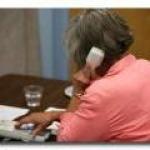New Research Finds Gambling Help Lines As A Potential Pathway To Treatment For People With Gambling Disorders
Toll-free hel

p lines have been a common first line of intervention for addictive disorders for many years with successful statewide tobacco help lines leading the way. While there has been research on gambling help lines since the 1990s, to our knowledge there has not been a study tracking help-line callers from their initial call to attendance at a counseling session – until now. With the percentage of people with a gambling disorder who seek treatment from a counselor, psychologist or self-help group such as Gamblers Anonymous at only between 7 and 12 percent (Slutske, 2006), the ability of a help line to promote attendance at a counseling session is vitally important. A new study published inPsychology of Addictive Behaviorsprovides data on the matriculation of people with gambling disorders from calling the help line to attending a counseling session and suggests potential best practices for increasing the number of callers seeking treatment (Weinstock et al., 2011).
Research Results
The researchers tracked data from more than 2,900 unique callers to the West Virginia Problem Gamblers Help Network (WVPGHN) from 2000 to 2009. The sample consists of all callers who were offered a referral for an in-person assessment and excludes people who did not qualify because they were not West Virginia residents, were calling inappropriately (i.e. prank calls) or their calls ended prematurely. Of the 2,900 callers who were offered a referral for treatment, 75 percent accepted the referral. Of that 75 percent, 72 percent attended the in-person assessment. Overall, 55 percent of people who were offered an in-person assessment by the help line staff attended the session.
Best Practices
The researchers suggest some methods for increasing assessment attendance. For example, the WVPGHN used a “warm transfer” method for referrals wherein the caller stayed on the line as the help line staff called a local clinician and scheduled an appointment. The “warm transfer,” along with other methods, such as scheduling the appointment within 72 hours of the call, have been shown to increase the caller’s attendance at the in-person assessment.
There are also demographic and clinical factors that influence whether or not callers attended the assessment. For example, callers with more severe problems and callers who may have been coerced to call (due to legal problems or pressure from a family member) were more likely to accept the referral and attend the session. Gender also played a role in attendance, with women being more likely to call the help line and make an appointment, but men more likely to attend the session. The researchers hypothesize that female callers may have more unstable home environments, a factor that can cause them to miss appointments with greater frequency (e.g. because of an inability to secure childcare or transportation).
More information about the article is available on thePsychology of Addictive Behaviors‘ website. Do you have thoughts or questions? Is there anything that you think would increase the number of people who seek treatment for gambling disorders? Let us know in the Comments section below.
References
Slutske, W. S. (2006). Natural recovery and treatment-seeking in pathological gambling: results of two U.S. national surveys.American Journal of Psychiatry,163(2), 297-302. doi:163/2/297 [pii] 10.1176/appi.ajp.163.2.297
Weinstock, J., Burton, S., Rash, C. J., Moran, S., Biller, W., Krudelbach, N., Phoenix, N., et al. (2011). Predictors of engaging in problem gambling treatment: Data from the West Virginia problem gamblers help network.Psychology of Addictive Behaviors: Journal of the Society of Psychologists in Addictive Behaviors. doi:10.1037/a0023240
*Photo by Flickr creative commons user willy_ochayaus
NCRG staffResearch Updategambling help linesinterventions for problem gamblingnew researchtreatment for pathological gambling

